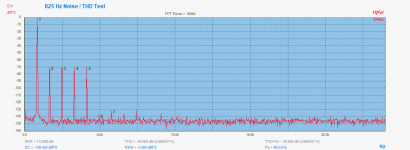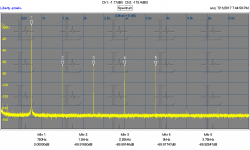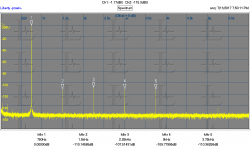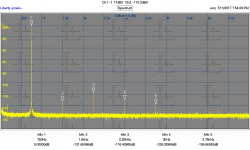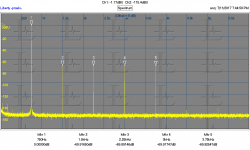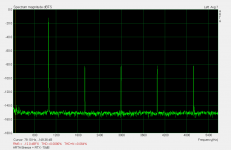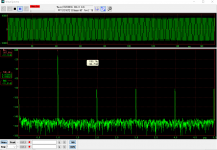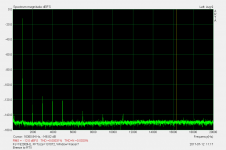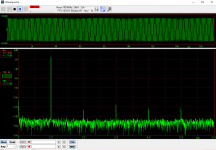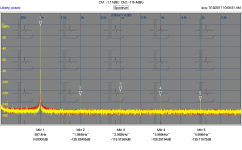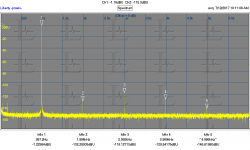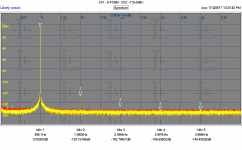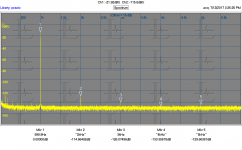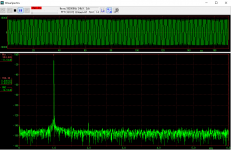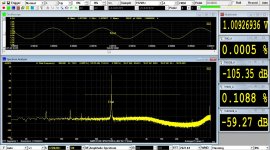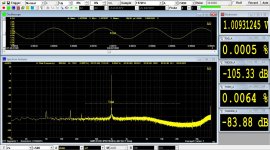Now, we identified the fundamental problems in FFT analysis and know how to overcome these issues: What can be done to achieve accurate noise and THD+N readings?
Just use a larger FFT Sample Size as 65k and the right SW who deals or is able to deal with.
Cheers
Hp
Why would an FFT length of 65k or more give correct results, but shorter FFTs don't?Just use a larger FFT Sample Size as 65k and the right SW who deals or is able to deal with.
Cheers
Hp
Gesendet von meinem D5803 mit Tapatalk
Why would an FFT length of 65k or more give correct results, but shorter FFTs don't?
If you are able to get accurate results using 256 FFT, then 😀
and guessing that you know how to get the FFT-Bin / freq step...
Just study my given RBW calculation sheet ..
Cheers
Hp
Just use a larger FFT Sample Size as 65k and the right SW who deals or is able to deal with.
Cheers
Hp
alright, the measurents posted before:
http://www.diyaudio.com/forums/atta...in5-aout1-loopback-0v_virtins_hann_48k_01.jpg
and
http://www.diyaudio.com/forums/atta...25hztestsignalat1vrms_virtins_hann_48k_01.jpg
were 131072 long FFTs. What went worng? I'd expect the THD+N to be very similar to the THD.
Where can I have a look at the RBW-spreadsheet you mention?
What is the/a LDO? (I dont think its describing a linear low drop out voltgae regulator in this context 🙂)
We need clarity from HP here but a few possible concepts-
1) LDO low distortion oscillator
2) high sample size will improve the possibility that the harmonics will land in a bin
One presumption is that the peak of the highest bin is the amplitude of the signal. If the bin match is off enough the level will be off. The ideal would be to sum the levels in several bins around the harmonic.
1) LDO low distortion oscillator
2) high sample size will improve the possibility that the harmonics will land in a bin
One presumption is that the peak of the highest bin is the amplitude of the signal. If the bin match is off enough the level will be off. The ideal would be to sum the levels in several bins around the harmonic.
What went worng? I'd expect the THD+N to be very similar to the THD.
Did a 825hz/48kHz & 16k FFT simulation test using the RME ADI-2 Pro in loop-back connection.
Just a small hint to your issue: May use a better FFT Window than Hanning (2-Term) while I used a 7-Term Blackman only...
Hp
Attachments
Here is a first pass on some measurements with the RTX. I used 750 Hz as the fundamental (even division of 48 KHz) and multiples which should all land in bins. Down side is that it won't exercise all the bits the same as a non integral division of the sample rate. I used Praxis for this since I know it well and the signal generation tools are pretty capable.
I checked the results with the Shibasoku 725d which can measure the individual harmonics and the numbers matched pretty precisely. As you can see at -130dB the internal distortion of the DAC (AK4490) starts to be significant and alters the levels. The altered levels in the plot are the same as measured by the 725d so the limitations of the ADC are not showing. Also this is at -1 dBFS, where the performance is not the best for the DAC. I'll do more measurements at -10 and -15 dB to see the effect of less fundamental along with other tests tomorrow.
I checked the results with the Shibasoku 725d which can measure the individual harmonics and the numbers matched pretty precisely. As you can see at -130dB the internal distortion of the DAC (AK4490) starts to be significant and alters the levels. The altered levels in the plot are the same as measured by the 725d so the limitations of the ADC are not showing. Also this is at -1 dBFS, where the performance is not the best for the DAC. I'll do more measurements at -10 and -15 dB to see the effect of less fundamental along with other tests tomorrow.
Attachments
2) high sample size will improve the possibility that the harmonics will land in a bin
They will always land in a bin, independent of the sample size. Longer FFTs will just produce more and narrower bins, thus improve the frequency resolution of the analysis.
Some more plots. The source is a file at approx 997 Hz with 4 harmonics all at -70 dB. I verified the harmonic levels with the Shibasoku 725D.
These are 4 different software packages measuring from the Breeze DAC (AK4490, same as RTX) to the RTX6001. Basically they all show the same results. Each package has pro's and cons in user interface and setup. Arta is limited in its resolution. I had some challenges getting Audiotester set to useful settings (more UI stuff) and saving the plot is not obvious on most of these.
I need some help with audiotester settings. As shown there is a windowing/sample catching issue somewhere.
Wavespectra was pretty easy to use but I could not find the averaging setting if there is one.
ARTA is limited to 131K FFT. I used 1M FFT's where available.
Praxis has a THD calculator option but I never use it for what I'm doing.
I'll post some resilts of -110 dB harmonics and -130dB harmonics.
These are 4 different software packages measuring from the Breeze DAC (AK4490, same as RTX) to the RTX6001. Basically they all show the same results. Each package has pro's and cons in user interface and setup. Arta is limited in its resolution. I had some challenges getting Audiotester set to useful settings (more UI stuff) and saving the plot is not obvious on most of these.
I need some help with audiotester settings. As shown there is a windowing/sample catching issue somewhere.
Wavespectra was pretty easy to use but I could not find the averaging setting if there is one.
ARTA is limited to 131K FFT. I used 1M FFT's where available.
Praxis has a THD calculator option but I never use it for what I'm doing.
I'll post some resilts of -110 dB harmonics and -130dB harmonics.
Attachments
This is the RTX loopback, RTX + Breeze Dac or the Victor Oscillator. No harmonics added on any. The loopback gets better performance but some may have to do with balanced drive in the loopback vs. single ended connection to diff in on the RTX. The last two are Wavespectra and ARTA.
There does seem to be some inconsistencies in how they all calculate the noise in THD+N.
The Breeze is playing a file hosted on a remote server via a small Linux player. its running on a 15V supply. While not as good as the RTX not bad for $80 + an LME49720.
I created the files initially using Praxis which can make a 10 second file. I used Audacity to extend the files. Later I moved on to using either Praxis or the Altor digital generator into an RME 9632 digital in and recording using the built in RME recording system. The level on that is a precise -15 dBFS at 1 KHz (24/192). I have found that getting accurate levels on digital files generation is a bit of a PITA. There is a bit of sloppiness on that with some apps. The Altor is the easiest and most predictable.
There does seem to be some inconsistencies in how they all calculate the noise in THD+N.
The Breeze is playing a file hosted on a remote server via a small Linux player. its running on a 15V supply. While not as good as the RTX not bad for $80 + an LME49720.
I created the files initially using Praxis which can make a 10 second file. I used Audacity to extend the files. Later I moved on to using either Praxis or the Altor digital generator into an RME 9632 digital in and recording using the built in RME recording system. The level on that is a precise -15 dBFS at 1 KHz (24/192). I have found that getting accurate levels on digital files generation is a bit of a PITA. There is a bit of sloppiness on that with some apps. The Altor is the easiest and most predictable.
Attachments
Some more plots. The source is a file at approx 997 Hz with 4 harmonics all at -70 dB. I verified the harmonic levels with the Shibasoku 725D.
These are 4 different software packages measuring from the Breeze DAC (AK4490, same as RTX) to the RTX6001. Basically they all show the same results. Each package has pro's and cons in user interface and setup. Arta is limited in its resolution. I had some challenges getting Audiotester set to useful settings (more UI stuff) and saving the plot is not obvious on most of these.
I need some help with audiotester settings. As shown there is a windowing/sample catching issue somewhere.
Wavespectra was pretty easy to use but I could not find the averaging setting if there is one.
ARTA is limited to 131K FFT. I used 1M FFT's where available.
Praxis has a THD calculator option but I never use it for what I'm doing.
I'll post some resilts of -110 dB harmonics and -130dB harmonics.
Hmm, the beef question was how the SNR / THD / SNR+THD gets on those plots, while Black_Chicken was reading false results.
hp
I hope to get more insight on the differences and where they come from. At -70 and even -110 the plots are pretty consistent. The noise and THD+N numbers are suspicious however as everything goes lower.
<snip>
Wavespectra was pretty easy to use but I could not find the averaging setting if there is one.
<snip>
Take a look at the bottom left corner of the main window in Wavespectra - I believe that's the averaging setting.
Attachments
I'll try to get some more measurements this weekend. I have made the -70 dB and the -110 db files available here: Demian Tri Band files I have set up and will be able to create files for -60 db to -110 dB. I need them to calibrate and verify the Shibasoku's ranging. Let me know if anyone else needs them. Its a bit of a pain to make the files so I want to do it once.
Just starting to play with audiotester as I now have my temporary hacky usb analyzer/generator completed. Managed to get dac thdn to 3 zeros, and the input to .0015ish with a pot front end I can adjust to get into the happy zone. Obviously, 10s of kohms before and after pot, ac coupled. "Works" I guess 🙂. Balanced output is not happy driving amplifiers, suppose that comes with the architecture, but iirc the dscope never had issues driving a car audio amp balanced at work. Rising distortion pretty quickly with medium levels here. Not a load problem.. Single ended works fine though. Tried ac coupling, tried trafo.. But this is more for my entertainment than anything.
Aaaanyway, jw if anyone had played more with virtins yet? Pretty happy with audiotester, but don't want to rush into purchasing. Going to play around with some various software's this weekend.
Looking forward to the rtx. 🙂
Aaaanyway, jw if anyone had played more with virtins yet? Pretty happy with audiotester, but don't want to rush into purchasing. Going to play around with some various software's this weekend.
Looking forward to the rtx. 🙂
I just found out that my HpW trial license has expired, therefore i can not replicate your measurements.
Playing with my new "LDO" ( 😉 thanks for the clarification) I was able to access the THD limit of my FireFace.
(1) Hanning
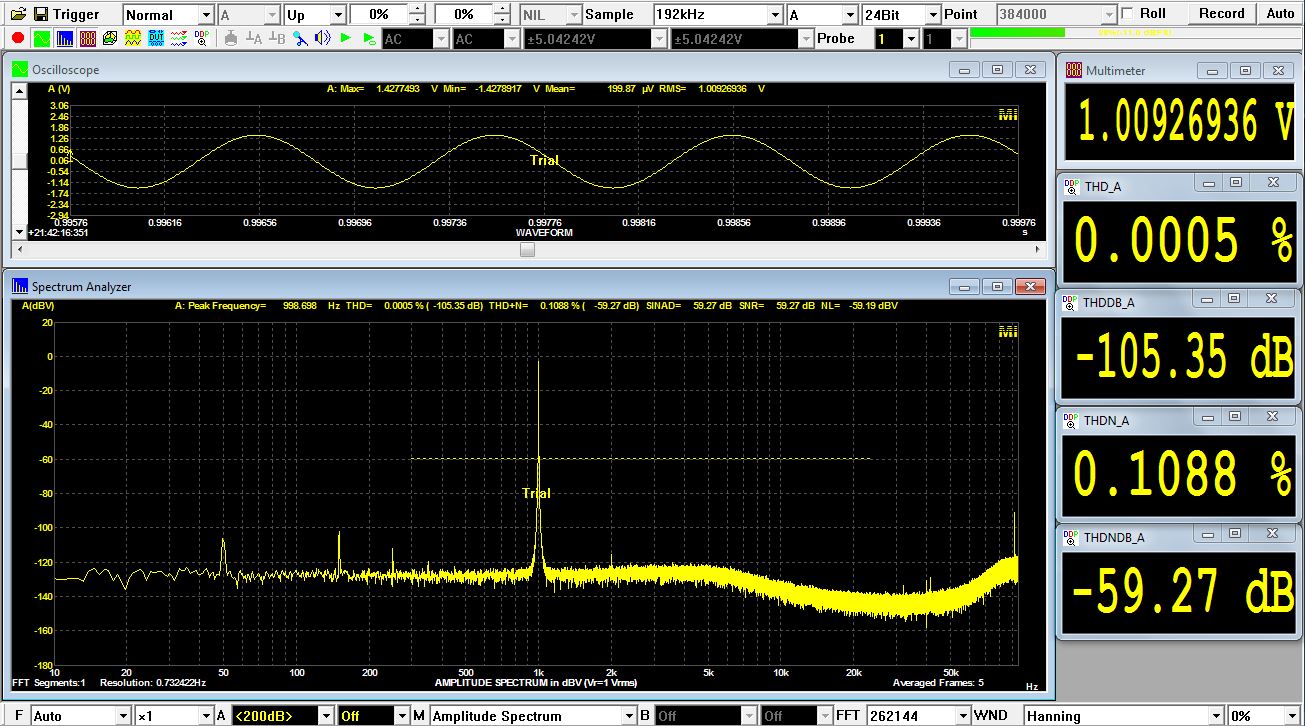
(2) Blackman Harris
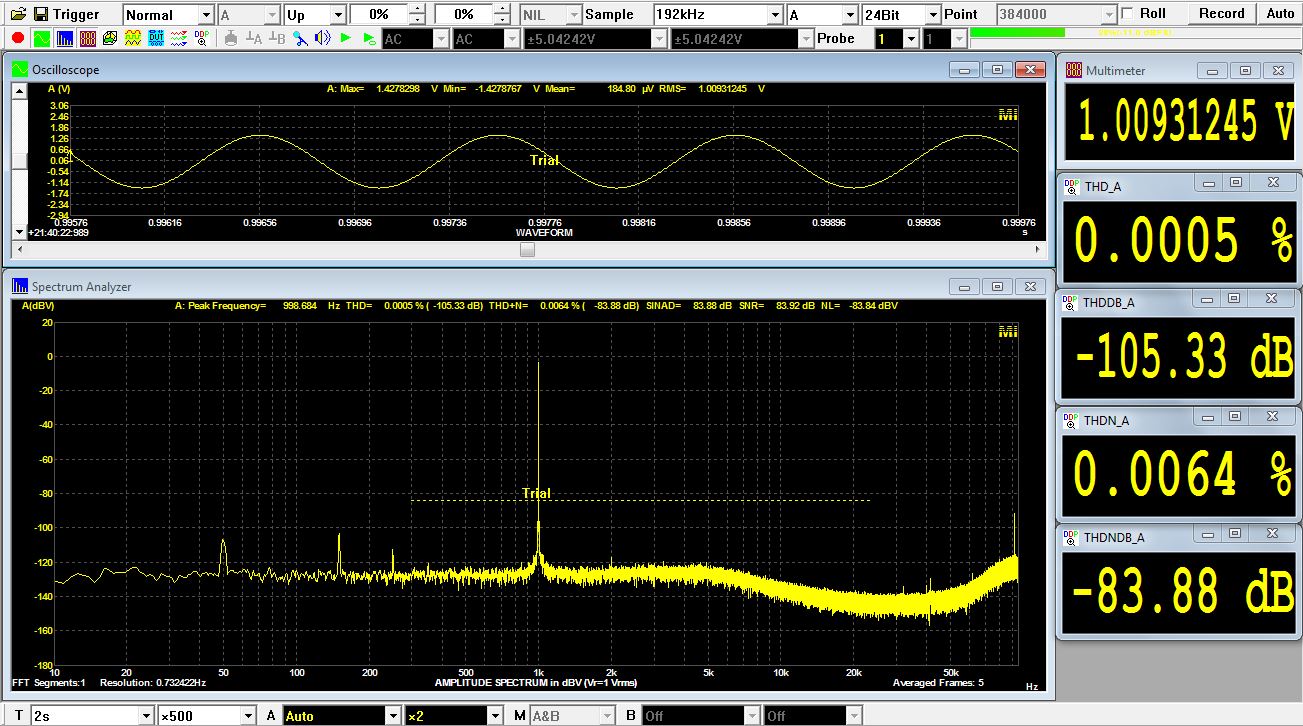
THD appear similar, THD+N differ quite a bit.
Please ignore the mains-induced hum... that was purely radiated interference from a different test instrument.
Playing with my new "LDO" ( 😉 thanks for the clarification) I was able to access the THD limit of my FireFace.
(1) Hanning
(2) Blackman Harris
THD appear similar, THD+N differ quite a bit.
Please ignore the mains-induced hum... that was purely radiated interference from a different test instrument.
Attachments
RTX 6001 “Getting Started” tutorial
Hello All,
Delivery of the RTX6001 Audio Analyzer is due in just a few weeks.
What is the short path to getting this beast up, running and seeing results?
Are any of you DIY Professionals thinking of posting a “Getting Started” tutorial?
What is the cheapest easiest software application to get up and running when we receive our RTX in the post?
Thanks
DT
Hello All,
Delivery of the RTX6001 Audio Analyzer is due in just a few weeks.
What is the short path to getting this beast up, running and seeing results?
Are any of you DIY Professionals thinking of posting a “Getting Started” tutorial?
What is the cheapest easiest software application to get up and running when we receive our RTX in the post?
Thanks
DT
- Status
- Not open for further replies.
- Home
- Design & Build
- Equipment & Tools
- Analyzer Software Overview
